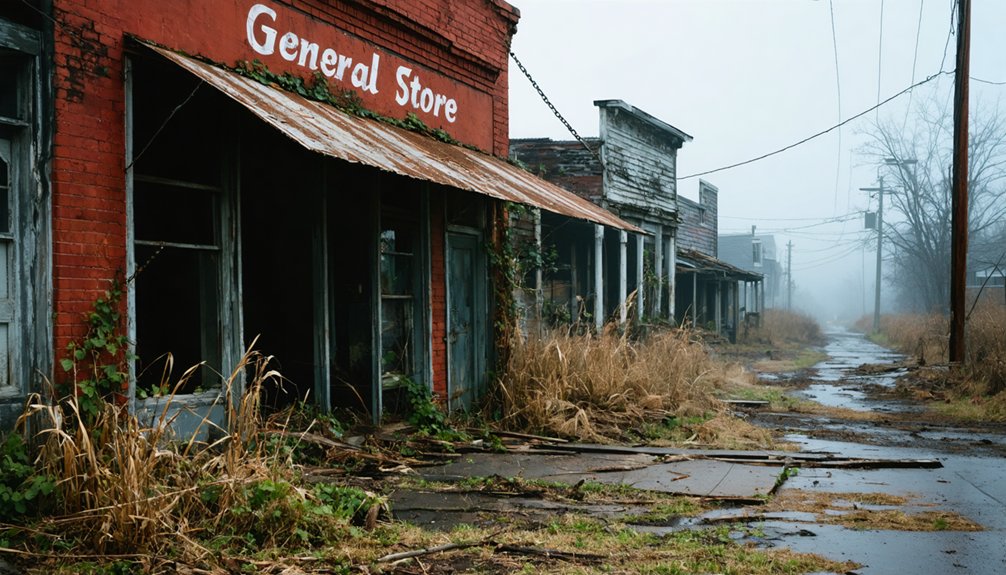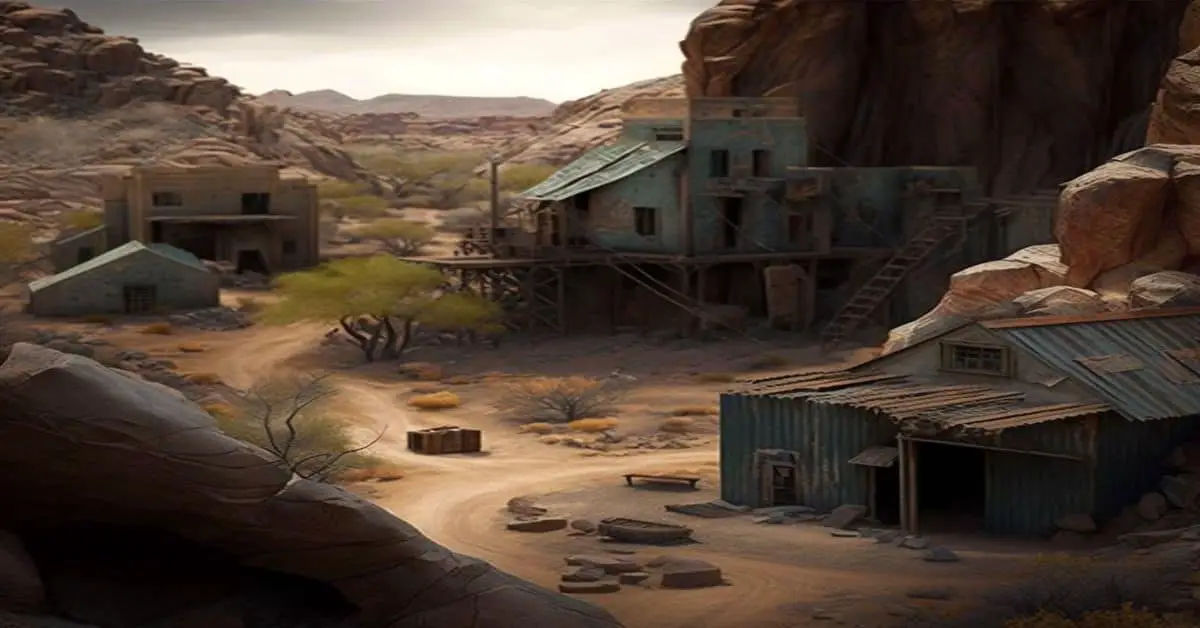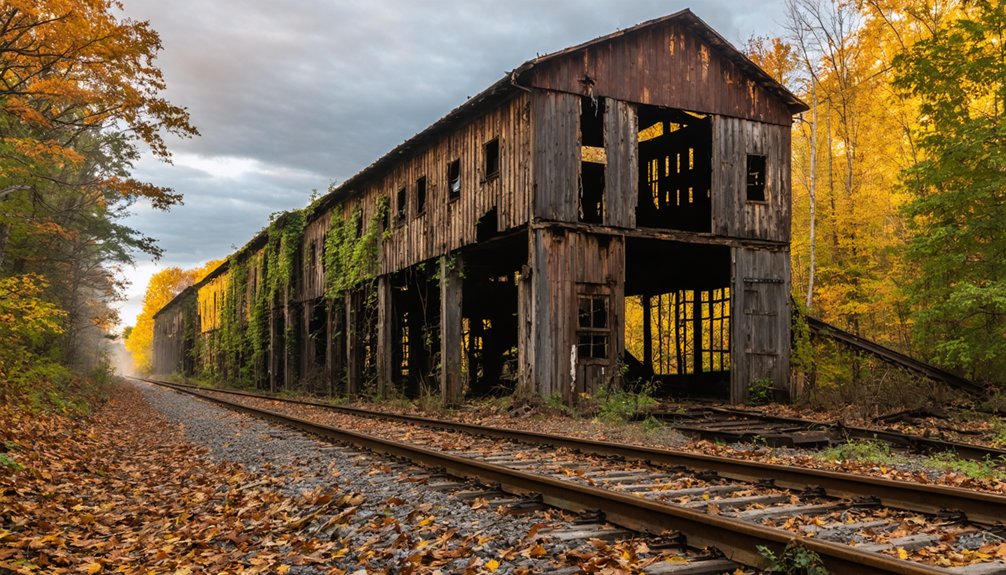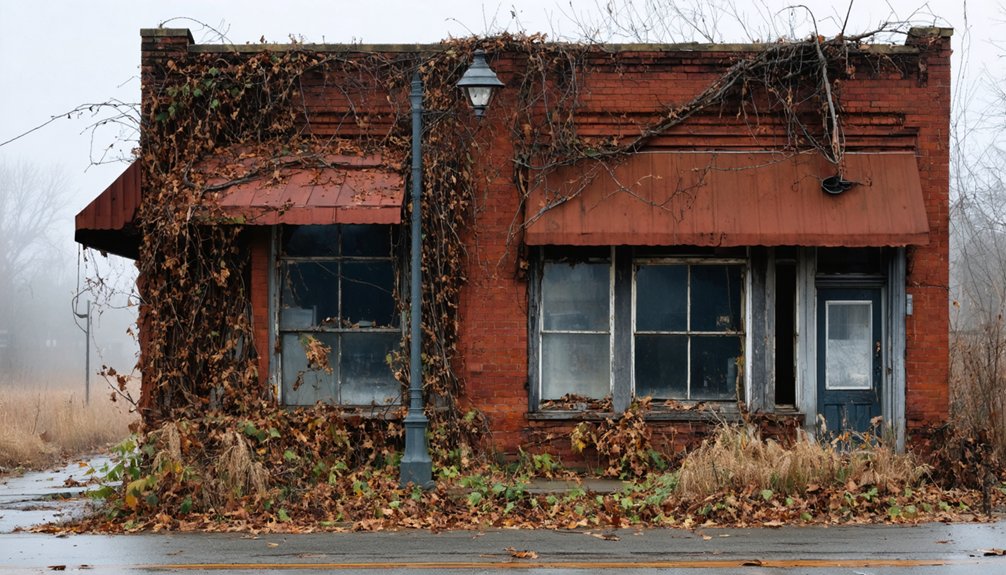You’ll find Berlin’s ghost town remnants in Johnson Township’s southeast corner, where German settlers established a thriving prairie community in 1847. The town flourished briefly through agriculture but declined in the late 1800s due to economic shifts and mechanization. Today, no structures remain visible at the site, which has returned to farmland. Berlin’s story mirrors many small Midwestern farming communities’ rise and fall, with deeper historical layers waiting to be uncovered.
Key Takeaways
- Berlin was established in 1847 as a German prairie settlement in Johnson Township, Indiana, driven by affordable farmland and agricultural opportunities.
- The town’s absence of major water bodies or transportation routes contributed significantly to its eventual decline and ghost town status.
- Economic shifts, agricultural mechanization, and population losses in the late 1800s led to the closure of local businesses.
- By the 1960s-1970s, widespread farmland loss and farm consolidation eliminated Berlin’s agricultural foundation and community viability.
- No physical structures or markers remain today, with Berlin’s former location completely transformed into rural farmland.
Birth of a Prairie Settlement
While German settlers had already established communities throughout Indiana by the early 1800s, Berlin emerged as a distinctive prairie settlement shaped by immigrants seeking affordable farmland and new opportunities.
You’d find these settlers weren’t just individual homesteaders but entire families and community groups drawn together by shared settler motivations: fertile soil, religious freedom, and escape from depleted eastern lands.
Breaking the thick prairie sod demanded specialized plows and collective effort, but the fertile ground promised abundant harvests of corn and wheat.
Similar to the Gardeners Benefit Society established by other German immigrants in Indianapolis, these pioneering families quickly established churches, schools, and social organizations that mirrored their German heritage.
To maintain community cohesion, these pioneering families quickly established churches, schools, and social organizations that mirrored their German heritage.
They adapted to prairie challenges by purchasing woodlots for building materials and applying their skilled trades to establish essential services like grist mills and sawmills. Like many early Indiana settlements, Berlin’s residents relied heavily on flatboat transport to move their agricultural goods to market.
Life on Indian Prairie
Long before Berlin’s German settlers arrived, the Indiana Prairie teemed with diverse Native American communities, particularly the Miami, Lenape, Pottawatomie, and Shawnee peoples.
You’d have witnessed thriving Native American agriculture, with tribes cultivating the rich prairie soil while supplementing their diet through hunting and gathering. These communities masterfully adapted to the land’s resources and developed sophisticated Prairie trade dynamics. The Mississippian culture that preceded these tribes established densely populated settlements in the Ohio River Valley.
When French explorers first ventured into the region in the 1670s, they encountered well-established societies with complex alliances.
The introduction of European firearms and trade goods transformed traditional relationships among tribes. You would’ve seen the Miami emerge as the dominant force, though they often welcomed displaced eastern tribes like the Lenape. The Miami tribes established semi-permanent villages where they lived seasonally and hunted from camps.
This delicate balance would later unravel as settlement pressures mounted in the late 1700s.
Geographic Setting and Features
In the southeast corner of Johnson Township, you’ll find the former site of Berlin nestled within Indiana’s historic Indian Prairie region.
The prairie’s flat, open terrain made it attractive for early settlement and agricultural development when the town was platted in 1847. Similar to many ghost towns in America, Berlin’s story reflects the broader socio-economic changes that transformed rural communities during westward expansion.
The landscape’s rich soil composition supported farming activities, though the absence of major water bodies or transportation routes ultimately contributed to the settlement’s decline. By the time the early 1900s arrived, Berlin had completely vanished from local maps.
Prairie Settlement Location
Nestled in the southeast corner of Johnson Township, Clinton County, Indiana, the ghost town of Berlin once occupied a portion of Indian Prairie’s fertile landscape.
You’ll find the site amid the characteristically flat to gently rolling prairie geography that defined much of central Indiana’s settlement patterns in the mid-1800s. The town’s 1847 platting placed it squarely within the open grasslands, where fertile soil promised agricultural prosperity.
Though you won’t find major rivers or lakes directly adjacent to Berlin’s location, the region’s typical prairie environment would’ve supported both farming and small community development. Like its German capital namesake situated along the banks of the Spree River, this Indiana Berlin lacked significant waterways to aid its development. With approximately one-third forests and parks in its namesake city, the Indiana settlement stood in stark contrast on its largely treeless prairie.
The town’s positioning away from primary river valleys and major transport routes likely influenced its eventual fade into obscurity by the early 1900s.
Township Landscape Features
The geographic setting of Berlin reflects the classic Grand Prairie landscape of central Indiana, marked by its characteristically flat terrain and rich prairie loams.
You’ll find no dramatic elevation changes or significant water features in this section of Johnson Township, Clinton County. The land use patterns tell a story of transformation from tallgrass prairie and scattered oak savanna to cultivated fields.
When you explore the area today, you’ll notice how the original vegetation patterns have given way to agricultural development. Unlike Berlin, Nevada, which was established after gold and silver discovery in the mountains, this area was purely agricultural from its inception.
The township’s layout follows the cardinal grid system typical of prairie settlements, with straight roads cutting through farmland. While small creeks and drainage networks dot the landscape, they’re modest in scale, serving primarily agricultural needs rather than transportation.
The fertile soil continues to support extensive farming operations, much as it did in Berlin’s heyday.
The Decline Years
You’ll find that Berlin’s decline began as economic shifts in the late 1800s fundamentally altered the sustainability of small farming communities across Indiana.
Similar to ghost towns across Indiana, Berlin’s fate was tied to the broader changes in settlement patterns and economic conditions that reshaped the state’s landscape.
The town’s inability to attract new industries or transportation connections accelerated population losses as residents sought opportunities elsewhere.
Agricultural mechanization and changing market conditions drove the final exodus of families from Berlin by the early 1900s, effectively sealing its fate as another Indiana ghost town.
Economic Shifts Impact Community
While Berlin, Indiana thrived as an agricultural hub after its 1847 founding, several economic factors converged to trigger the town’s eventual decline.
You’ll find that the town’s economic resilience was severely tested when railroad expansion bypassed the community, shifting commerce to better-connected areas. The lack of transportation access proved devastating for local businesses.
The community’s adaptation efforts were hampered by their sole reliance on agriculture. Without mining resources or industrial development to diversify the economy, Berlin couldn’t sustain itself when modern farming practices reduced the need for small-town services.
As younger workers left for industrial jobs elsewhere, local enterprises – from general stores to blacksmiths – shuttered their doors. The absence of banking institutions and deteriorating infrastructure accelerated the town’s transformation into a ghost town.
Population Loss Accelerates Downfall
As Berlin entered its decline years, dramatic population losses plagued not just the town but the entire surrounding region, with more than half of Indiana’s counties experiencing significant resident exodus.
You’ll find the population dynamics particularly stark in rural areas, where deaths now outnumber births in 62 of Indiana’s 92 counties. The rural depopulation hit nearby counties hard – Perry lost 1.84% of its residents, while Pulaski shed 1.64%.
Immigration hasn’t provided enough relief to offset these losses. While some urban areas like Indianapolis have grown, Berlin’s story mirrors the broader crisis in Indiana’s small towns, where outmigration intensified from 3,000 residents lost in 2000-2010 to over 9,000 in 2010-2020.
Agricultural Changes Bring Exodus
Throughout the 1960s and 1970s, Berlin’s agricultural foundation crumbled under the pressure of widespread farmland loss and economic shifts. You’d have witnessed the exodus of farming families as economic pressures forced them to sell their land to developers.
Despite agricultural innovation in crop yields and farming technology, Berlin’s farmers couldn’t overcome the combined challenges of poor soil quality, erosion, and market forces pushing them toward urban development.
While the Indiana State Department of Agriculture later championed farmland preservation initiatives, these efforts came too late for Berlin’s agricultural community. The town’s remaining farmers faced tough choices: adapt to more intensive farming practices, sell their land, or abandon it altogether.
As farms consolidated and families moved away, Berlin’s agricultural heritage – once the backbone of its economy – steadily disappeared.
Legacy in Clinton County
Despite its short-lived existence, Berlin’s legacy endures as a significant chapter in Clinton County’s historical narrative.
Though Berlin faded into history, its brief presence remains an enduring part of Clinton County’s rich past.
You’ll find traces of Berlin’s heritage woven into the region’s historical records, genealogical documents, and local folklore, preserving the memory of this Indiana ghost town that once stood on Indian Prairie.
The town’s story reflects broader patterns of pioneer settlement and community evolution in Clinton County.
While Berlin didn’t survive the economic and demographic shifts that transformed the region, its existence contributes valuable insights into early settlement patterns following the Treaty of St. Mary’s in 1818.
The town’s rise and fall mirrors the experiences of many small settlements that emerged during Clinton County’s formative years, offering important lessons about community sustainability and adaptation in frontier America.
What Remains Today
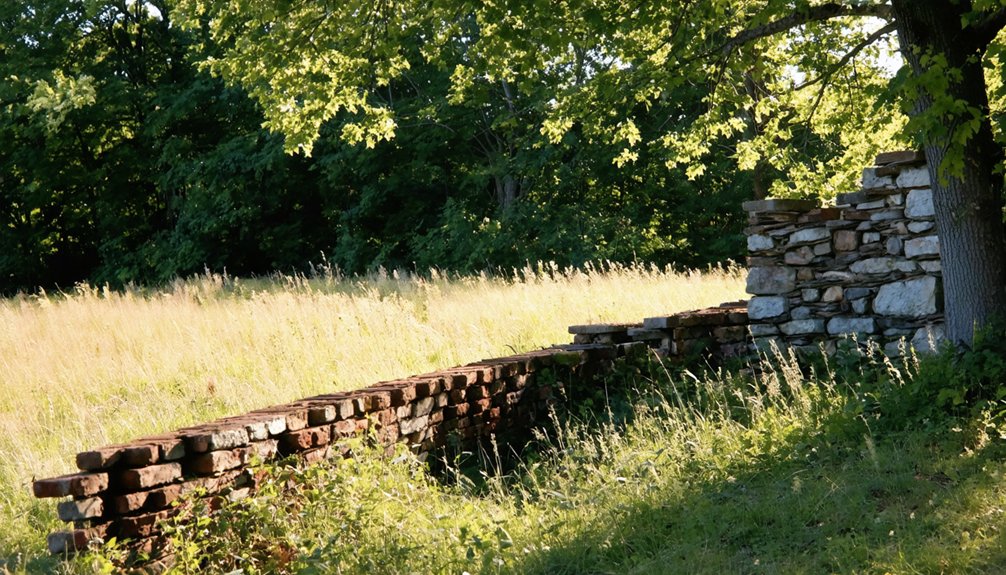
Time has erased nearly all physical traces of Berlin from Indiana’s landscape. Unlike other preserved ghost towns across America, you won’t find any standing structures or visible foundations at this extinct settlement.
The site’s transformation into rural farmland has left Berlin’s ghost town remnants virtually undetectable to the casual observer.
If you’re searching for Berlin today, you’ll encounter:
- No historical markers or interpretive signs
- No documented archaeological discoveries
- No preserved buildings or structural ruins
The absence of physical remnants has also impacted cultural memory, with no local traditions or community events keeping Berlin’s story alive.
Without archaeological surveys or preservation efforts, this forgotten settlement exists primarily as a name on Indiana’s ghost town registers, its exact location unclear to modern visitors.
Historical Significance and Records
While physical traces of Berlin have vanished, historical records paint a clear picture of this extinct Indiana settlement.
You’ll find Berlin’s story documented in official plat maps from the mid-1800s, showing its planned layout within Johnson Township, Clinton County. Historical documentation reveals Berlin’s establishment in 1847 on Indian Prairie, followed by its gradual decline through the late 19th century.
Like many ghost town narratives in Indiana’s history, Berlin’s tale is preserved through state archives, land records, and township histories.
While census data remains limited due to the town’s brief existence, you can trace its administrative presence through geographic repositories and historical datasets.
Berlin stands as a prime example of the many small Midwestern settlements that emerged – and disappeared – during America’s 19th-century expansion.
Frequently Asked Questions
Were Any Notable Crimes or Mysteries Recorded in Berlin’s History?
You won’t find documented criminal activity or unsolved mysteries specifically in Berlin’s records, though nearby ghost towns like Tunnelton experienced violent events including an 1882 shootout with thieves.
What Were the Most Common Occupations of Berlin’s Original Settlers?
Nearly 80% of Berlin’s settlers were farmers, and you’d find them practicing corn cultivation and hog raising. They’d supplement their living with trades supporting farming techniques and nearby trade routes.
Did Berlin Have Its Own School, Church, or Cemetery?
You won’t find any clear records of a school, church, or cemetery in Berlin. Based on the town’s short history and rapid decline, it’s unlikely these institutions were ever established.
What Was the Peak Population of Berlin During Its Existence?
You won’t find exact peak population records for this settlement, as historical data wasn’t well preserved. While the town saw modest growth during its peak industry years, settlement patterns weren’t extensively documented.
Did Any Famous or Historically Significant People Come From Berlin?
You won’t find any famous residents or historical figures from Berlin, Indiana in recorded history. Available research shows no documented prominent individuals emerged from this short-lived 19th-century settlement.
References
- https://www.atlasobscura.com/places/city-west-ghost-town
- https://www.wikiwand.com/en/articles/Berlin
- https://en.wikipedia.org/wiki/Berlin
- https://www.youtube.com/watch?v=X6kmlnj7oYs
- https://opendata.renenyffenegger.ch/Wikimedia/Wikidata/entity/Q4892345
- https://www.atlasobscura.com/users/lendog666/lists/ghost-towns
- https://en.wikipedia.org/wiki/List_of_ghost_towns_in_Indiana
- https://www.historymuseumsb.org/pioneer-settlement-in-indiana-1790-1849/
- https://indianahistory.org/explore/our-collections/archives/ethnic-history-materials/
- https://en.wikipedia.org/wiki/Potawatomi_Trail_of_Death
